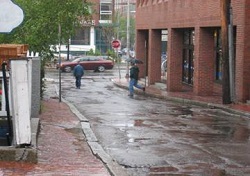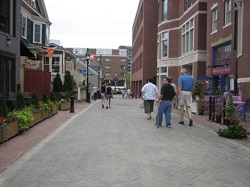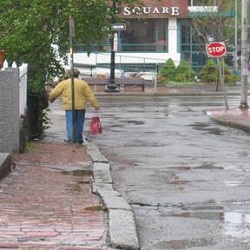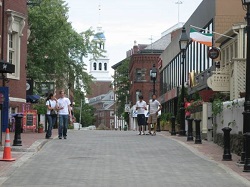Winthrop Street Shared Street
Cambridge, Massachusetts
Prepared by Ann McGrane, University of North Carolina Highway Safety Research Center. Information provided by Katherine Watkins, P.E., City of Cambridge, Cambridge, Massachusetts.
Cambridge, Massachusetts
Prepared by Ann McGrane, University of North Carolina Highway Safety Research Center. Information provided by Katherine Watkins, P.E., City of Cambridge, Cambridge, Massachusetts.

Winthrop Street before the project.
Winthrop Street in Cambridge, Massachusetts, was a neglected street with narrow sidewalks that did not conform to ADA guidelines. Due to the low traffic volume, pedestrians would often walk in the street rather than on the sidewalks.
The City of Cambridge, Massachusetts, is located across the river from Boston, and it is home to both Harvard University and the Massachusetts Institute of Technology. Because Cambridge was originally settled in the 1600s, its streetscape is composed of narrow roadways that are greatly influenced by pedestrian-based travel needs.

Winthrop Street after the project.
Winthrop Street was a small street between JFK Street and Eliot Street and was located near Harvard Square. The street had brick sidewalks that were in poor condition, very narrow, slippery when wet, and not a uniform height. The street felt more like an alley than an inviting pedestrian space. A number of restaurants were located near the street and vehicle speeds were low, which led officials at the City of Cambridge to consider transforming Winthrop Street into a shared street. Shared streets, which are based off of the Dutch woonerf, are spaces where pedestrians, bicyclists, and motor vehicles share the roadway.

Uneven, narrow sidewalks made pedestrian travel difficult.
As part of the Harvard Square Improvement Project, the City of Cambridge turned Winthrop Street into a shared street that was appealing to pedestrians and bicyclists. By removing the curbs and installing inter-locking concrete pavers, the City turned Winthrop Street into an inviting pedestrian space that could also accommodate motor vehicles and delivery vehicles to service the adjacent restaurants and businesses. The speed limit was posted at 10 mi/h, which discouraged motorists from using the street and made sure that motorists heeded pedestrian and bicycle traffic when they did use the street. Pedestrian-scale lighting improved the nighttime pedestrian environment, and the renovated shared street was ADA accessible. Restaurants were also allowed to add outdoor seating to the area, creating a vibrant and safe nighttime space.

Pedestrians feel comfortable walking in the middle of the street. Streetlights provide pedestrian lighting at night.
Completed in 2007, the Winthrop Street shared street was so popular that restaurant owners asked the city to close the street to traffic for a portion of each day so that the restaurants could increase their outdoor seating. The conversion of the street to a shared street improved pedestrian safety and accessibility because the old version of the street had narrow, uneven sidewalks that often forced people with mobility impairments to walk in the street. Now everyone has a wide, level path on which to walk. Due to the success of Winthrop Street, the City is currently in the process of designing a residential shared street to address accessibility issues on a dead-end street with narrow sidewalks that are inaccessible due to street trees.
Katherine Watkins, P.E.
Supervising Engineer
City of Cambridge
Cambridge, Massachusetts
Phone: (617) 349-4751
Email: kwatkins@cambridgema.gov